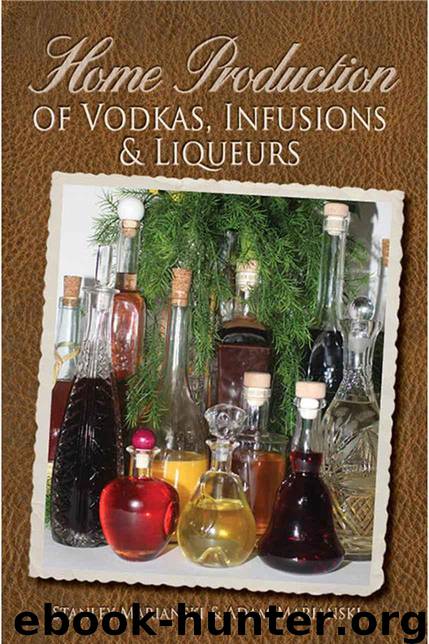Home Production of Vodkas, Infusions & Liqueurs by Marianski Adam & Marianski Stanley

Author:Marianski, Adam & Marianski, Stanley [Marianski, Adam]
Language: eng
Format: mobi
Publisher: Bookmagic LLC
Published: 2012-09-04T16:00:00+00:00
One of the best known producers is Bacardi from Puerto Rico. The factory makes light and medium rums, from 40 to 75%. Then there are many rums which are made in Martinique, Guadeloupe, Guyana, Barbados, Belize, Nicaragua and other islands or countries located in the Caribbean basin area.
This is where most sugar cane plantations have been established. However, rum is also produced in the Canary Islands of Spain, Australia, New Zealand, Fiji, Mexico, Hawaii, the Philippines, India, Mauritius, South Africa, and Canada.
The typical process consists of distilling the fermented sugarcane mash to about 70-75%. Distillation is performed twice and the distillate is usually 70-75% strong. Then it is aged for at least one year. The color of rum is influenced by the type of the aging container; the oak casks will make the rum brown but stainless containers will preserve the clear color of the distillate. Most rums are 40% grade but there are also 55% and 75% stronger ones, for example 75% Bacardi.
Many rums are flavored by the addition of spices and sometimes caramel. Popular spices are cinnamon, rosemary, aniseed, or pepper. Flavored rums are infused with flavors of fruits, such as banana, mango, orange, citrus, coconut, star fruit or lime.
Distilled alcoholic spirits are made with a standard method: fruit preparation, fermentation, distillation to the required alcohol strength which sometimes involves diluting distillate with water and aging. Although those spirits carry their own established names, they may be considered flavored vodkas as flavored vodkas can be a blend of different materials and flavorings.
You must realize by now that distillation is a fairly accomplished process that requires expensive equipment and a lot of space and time. What is even more important, distilling alcohol is illegal in the USA and most countries, so there is no need to go deeper into production details. However, one can buy strong alcohol and create his new combinations or imitate well known products, for example combining rum, brandy, alcohol, sugar and eggs to make a home version of Advocaat.
Distilling Infusions
Generally any fruit infusion can be distilled to make fruit flavored alcohol. The process is similar to making the first infusion method: fruit preparation, adding alcohol and maceration. The maceration process lasts only about 12 hours and the infusion is then distilled.
Gin
Gin is a spirit which derives its predominant flavor from juniper berries (Juniperus communis). The name gin is derived from either the French geničvre or the Dutch jenever, which both mean “juniper”. From its earliest beginnings in the Middle Ages, gin has evolved over the course of a millennium from an herbal medicine to a popular spirit of today. There are a few popular methods for making gin:
• Juniper berries are added into 75-85% alcohol, macerated for 12 hours and distilled.
• Juniper berries are covered with 50-60% alcohol and macerated for 14 days. This is a typical infusion process. Then the infusion is distilled.
• Juniper berries are soaked in water until they release juice. This may be repeated a few times using the juice from the previous maceration to soak new berries.
Download
This site does not store any files on its server. We only index and link to content provided by other sites. Please contact the content providers to delete copyright contents if any and email us, we'll remove relevant links or contents immediately.
| Buying Guides | Cellars |
| Champagne | Collecting |
| Spirits | Whiskey |
| Wine | Wine Pairing |
| Wine Tasting |
Whiskies (Collins Gem) by dominic roskrow(42207)
101 Whiskies to Try Before You Die by Ian Buxton(42175)
Whiskies Galore by Ian Buxton(40327)
Craft Beer for the Homebrewer by Michael Agnew(17445)
Right Here, Right Now by Georgia Beers(3497)
Not a Diet Book by James Smith(2723)
Water by Ian Miller(2580)
The Coffee Dictionary by Maxwell Colonna-Dashwood(2529)
Kitchen confidential by Anthony Bourdain(2306)
Coffee for One by KJ Fallon(2006)
Smuggler's Cove: Exotic Cocktails, Rum, and the Cult of Tiki by Martin Cate & Rebecca Cate(1979)
Beer is proof God loves us by Charles W. Bamforth(1919)
Superfood Smoothie Bowls: Delicious, Satisfying, Protein-Packed Blends that Boost Energy and Burn Fat by Chace Daniella(1901)
Talking as Fast as I Can by Lauren Graham(1828)
Bourbon: A Savor the South Cookbook by Kathleen Purvis(1790)
A Short History of Drunkenness by Forsyth Mark(1717)
Eat With Intention by Cassandra Bodzak(1686)
Cocktails for the Holidays by Editors of Imbibe magazine(1624)
Colombia Travel Guide by Lonely Planet(1608)
